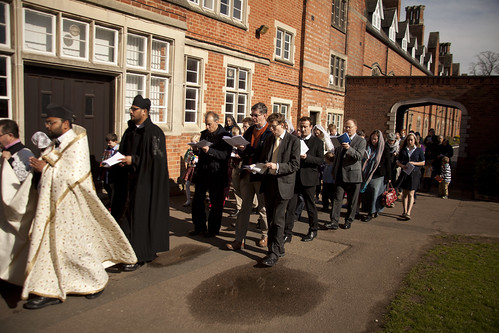Chairman's Blog
The Church's calendar and popular culture
Reposted from 2014.
--------------------------------------
Yesterday was St Valentine's Day. That is what a thousand shop windows, restaurant menus, and service station card racks proclaimed. St Valentine was a martyr of the 3rd Century, over whose tomb a basilica was built when he Church's time of persecution was over. I attended Mass in his honour, and in the name of the Church the celebrant implored God's mercy in light of St Valentine's merits.
Collect:
Grant, we beseech Thee, O almighty God, that we, who celebrate the heavenly birthday [ie, death] of blessed Valentine, Thy Martyr, may by intercession be delivered from all the evils that threaten us. Through our Lord...
Secret:
We beseech Thee, O Lord, graciously receive the gifts we offer Thee: and may they, in view of the merits of Thy blessed Martyr Valentine, be of help to us towards our salvation. Through our Lord...
Postcommunion:
O Lord, may this heavenly Mystery be to us the renewal of of soul and body, that by the intercession of the blessed Valentine, Thy Martyr, we may feel the influence of this Sacrifice. Through our Lord...
This, of course, was Mass in the Extraordinary Form. In the Ordinary Form we don't find mentions of Sacrifice scattered through the proper prayers. Or the merits of the saints. Or their intercession. Nor is it made as clear as this that the gifts we offer God in Mass are not the unconsecrated bread and wine, but the Body and Blood of Christ by which are saved. And then again, in the Ordinary Form St Valentine is not celebrated on his historic feast day, the day of his death all those centuries ago.
It is hard to find anyone (at least, on Twitter) willing to defend the decision to take away the liturgical celebration of the saint who has, however unwillingly, given his name to the secular phenomenon of Valentine's Day. But by chance I read something which suggests that it may not be just a coincidence, that in their clear-out of the saints of ancient Rome from the calendar (where they used to be heavily represented: this is, after all, the Roman Rite we are talking about), the reformers turfed out someone with the cultural significance of St Valentine.
It was Bugnini, talking about Ash Wednesday. It is inconvenient to have it on a Wednesday, he thought; much better on a Sunday. This is impossible, however: you can't have a penitential liturgy on a Sunday. So he had to leave it on Wednesday after all. (A close shave for another ancient tradition!) But he wanted to allow the imposition of Ashes to take place any day between Ash Wednesday and the following Monday. Having it on the Wednesday, you see (The Reform of the Liturgy, p307, n7)
 |
| In England, admittedly, the celebration of the day before Ash Wednesday is a little more restrained. |
'had the drawback of keeping the association with Mardi Gras.'
Come again? The association with Mardi Gras is a drawback? The fact that calendar and the practice of penance has become so deeply embedded in popular culture that it is impossible to avoid it, in many cultures: this is a bad thing?
A third example occurs to me: Halloween, the Eve of All Hallows (All Saints). When All Saints falls on a Saturday or a Monday, the bishops of England and Wales, in their wisdom, move it to Sunday. This means that, except in the Extraordinary Form, Halloween is not followed by All Saints. Either it is separated from it by a day, or it falls on the same day. This horrible clash happened in 2010. But perhaps the bishops, when this decision was made (many years ago), didn't actually want to make the connection with Halloween.
What is going on here? It is true that in each case, the secular celebrations have taken a problematic turn. In the case of Mari Gras, this has been the case for many centuries. They have become unCatholic, to say the least. The response of Bugnini and those who think like him seems to be that we should retreat into a bunker, at this point, stick our fingers in our ears and pretend that they are not happening, or at least have nothing to do with us. The Church, they seem to think, should disown them. This kind of response is regularly made by puritanical types in relation to the secular celebration of Christmas: we should eschew Christmas trees and Father Christmas and presents and having fun, and pretend this has nothing to do with the Birth of the Saviour.
The spirit of the New Evangelisation, however, takes the opposite view. These are opportunities to evangelise. We Catholic invented all these things, or (in the case of the Christmas tree and Father Christmas), have long made them our own. Even the worst aspects, the occult references in some places in Halloween, for example, are a sort of shadow of the Catholic teaching, and can give us the opportunity to talk about it. We don't need to approve of fornication on St Valentine's Day, or getting drunk on Mardi Gras, but rather than ignoring these things, we should engage with them. That is what Pope Francis was doing by giving special blessings to engaged couples on the ... feast of SS Cyril and Methodius, yesterday. (Funnily enough, the Vatican News Service called it the Feast of St Valentine. Those trads must be infiltrating...)
The liturgical reform is usually characterised as optimistic, open to 'secular values', and in some ways it is. I think, however, that deep down there was a lot of timidity, of fear, a feeling that the Church has lost control of popular culture and needs to return to the catacombs, where the chosen few can 'participate', and outsiders can be made to feel as though they have stumbled into an intimate gathering of chums. This attitude doesn't get us anywhere. We have to go out there and make use of whatever vestiges of Christianity we can find. Even those embedded in cultural artefacts with origins in anti-Catholic polemic can be useful, like cult of the anti-hero Guy Fawkes.
Soon, after all, there will be precious little in the way of Catholic institutions to shelter us.
Spring 2017 Mass of Ages now on sale
 Leading articles feature Buckfast Abbey, The Old Mass and Children, a round-up of an extraordinary Christmas for the Traditional Mass and Gregory Hogan reports on plans to open a new Catholic academy in the Diocese of Portsmouth. These, together with the usual features, a wealth of news, reviews and reports all show how love of the Traditional Mass is growing around the country.
Leading articles feature Buckfast Abbey, The Old Mass and Children, a round-up of an extraordinary Christmas for the Traditional Mass and Gregory Hogan reports on plans to open a new Catholic academy in the Diocese of Portsmouth. These, together with the usual features, a wealth of news, reviews and reports all show how love of the Traditional Mass is growing around the country.
If you're not a member, and may not see one in a local church this weekend, you can get one sent to you for just the postage from the LMS shop.
Support the work of the LMS by becoming an 'Anniversary Supporter'.
Christmas Card competition
| Best religious image: well done, ACN |
I will ill on the feast of Candlemas, and I am only just now taking down our Christmas cards, which we have enjoyed over the long Christmas season. The cost of postage seems to be gradually driving them out of fashion, but I think it is a good custom and I would be sad not to receive any.
In a post-Christmas spirit, I thought I'd post up the results of a little informal competition among the cards we received this year, which were as always an interesting selection, and included for the first time cards sold in aid of the Latin Mass Society.
The card above, was in my view the best traditional Christmas image. The prize goes to Aid to the Church in Need, which has long had an excellent selection. Their nearest rival among the cards we've been receiving over the years - at least, till the Latin Mass Society got in on the act - is SPUC, which didn't have such a good year I thought.
This below is what I thought was the least unacceptable secular image. Most secular cards go straight into the bin in my house, to keep the ugly religious ones company. (Zero tolerance for mawkish and otherwise bad art!) The boys are not University students, incidentally, but the pupils of William Shakespear's grammar school in Stratford, and the card seems to have been sold in this institution's support.
| Least unacceptable non-religious image: King Edward's School, Stratford upon Avon. |
Below is the most reiterated theme (excluding the Nativity itself of course). We received no fewer than four different cards showing a partridge in a pear tree. I think this one is charming.
| One of four different Partridge in a Peartree cards we received. |
The prize for the most obscure religious subject goes to Madeleine Beard, who like many artists uses her own very distinctive art for her cards. This rather fun image is of Our Lady of Pontmain. Let us hope Our Lady will have similar pity on the Church today that she had on France in January 1871.
The next one, by contrast, gets the wooden spoon for most badly-printed commercial card. The colours are garish and the images pixillated, and it comes from the Museum Selection, which seems to have gone downhill.
| Most badly printed commercial card: sorry, Museum Selection. |
This is the most outrageously religious card from a totally non-religious institution: in this case, a financial institution in the City of London. Cards to customers of commercial enterprises can be perfuctory, but in this case I shall be happy to continue to patronise them in 2017.
| Some hard-nosed City money-men catch a glimpse of the Light of the World. |
Finally, I thought this was the best card from a religious Institute. I received lovely cards from the Institute of Christ the King, the Fraternity of St Peter, and the Sons of the Most Holy Redeemer, but I liked best of all this year this large and handsome image of St Norbert receiving the Habit from Our Lady, and the Rule from St Augustine: from the Norbertines of Chelmsford.
May all our friends flourish this year!
And for those who still haven't taken down their decorations, take comfort from this. I read in an old book about decorating churches, that in the records of one Medieval English church the custom was to take the Christmas greenery down... on the First Sunday of Lent.
So you have a little time.
Support the work of the LMS by becoming an 'Anniversary Supporter'.
The Ancient Lectionary
Reposted from May 2013, in response to the strange blog post arguing for various improvements to the Extraordinary Form, one of which is that it adopt the OF Liturgical Calendar. (There's another response here, from the excellent Fr Albert Marcello.)
The lectionary seems to many to be an obvious example of something the OF does better than the EF, but it doesn't take long to see why things aren't so simple. The brevity, and the basis of the selection, of the traditional lectionary have their own advantages. As for swapping one lectionary for another, this would produce an incoherent muddle.
--------------------------------------------------
Today I'm publishing a Position Paper for the Una Voce Federation on the Lectionary. Go over to Rorate Caeli to read it.
As I remark there, the claim is often made that the lectionary of the 1970 Missal is an obvious improvement on the old one, on the simple basis that more is better, and the 1970 Missal has more scripture in it. Clearly, however, there are other considerations. First and foremost, the lectionary must make sense liturgically: if we understand that, we will understand the value of the old lectionary, in the context of the old Mass, and why it should be preserved. To replace it with the new lectionary, as if the lectionaries can just be swapped in and out of rites, would be a disaster for the Traditional Mass.
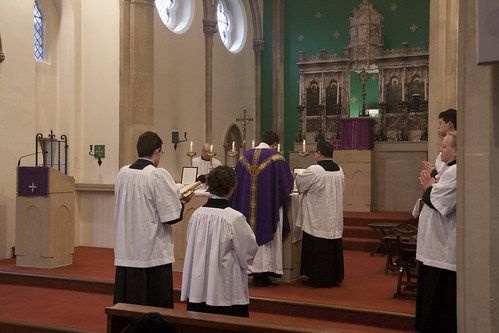 |
| One of the five extra readings on an Ember Saturday, celebrated in Caversham |
In the Traditional Mass, the readings of each Mass are connected with the other proper prayers and chants of that Mass. There is a series of Sundays (some of the ones After Pentecost) in which, for historical reasons, the gospels have got out of sync with the other propers by one week; because of the nature of the progression of texts this doesn't matter very much. What we never have, however, in the Traditional Mass is a set of readings with absolutely no connection with the chants or prayers, and that is something which is inevitable with a multi-year cycle of readings, unless it were accompanied by the multi-year cycle of prayers and chants. But, obviously, there aren't enough appropriate ancient prayers and chants to go round. (This, of course, is part of the story of why, in the Ordinary Form, the chants are a sort of optional extra, which don't seem very closely connected with the other liturgical texts.) Imposing a multi-year cycle of Sunday readings on the EF would destroy the coherence of its propers.
Another suggestion often made is that we should have a cycle of readings for the ferias outside Lent. There were, once, such cycles (though only for three days each week), so it might even seem a 'traditional' thing to do. Before trying to restore things from the distant past (in the Roman Rite, this cycle disappeared in about 13th Century), we should ask why things developed as they did. The answer is, probably (there is no record of a debate, this is one of those things which just happened), that with the rich sanctoral cycle, and the increasing use of Votive Masses, the ferial cycle didn't get much use outside Lent, so it was pretty pointless. If we want to reverse this development, we have to reverse the whole of it: we have to impoverish the sanctoral cycle, and get rid of Votive Masses. Or else render them liturgically incoherent by insisting on readings with no connection with the theme of those Masses. Is that something we really want to do?
Why not say, with Pope Pius XII, that what happened was an organic development which made the liturgy answer the developing needs of the Faithful? And that our needs are pretty well the same: we need the sactoral cycle, because we have lots of saints to celebrate, and we need Votive Masses, because we have lots of devotions to maintain. These two things, the saints and devotions, are major parts of Catholic life and spirituality, and have been since roughly the period in which the ferial cycle dropped out of use. It's not a coincidence.
Here's Pius XII, again:
Just as obviously unwise and mistaken is the zeal of one who in matters liturgical would go back to the rites and usage of antiquity, discarding the new patterns introduced by disposition of divine Providence to meet the changes of circumstances and situation.
This is all not to say that we can't increase our liturgical exposure to the scriptures. There are a couple of suggestions in the paper which deal with this, notably that, in line with the Second Vatican Council, the recitation of the Divine Office be encouraged. The readings of Sunday Matins are, in fact, closely connected with the readings of the Sunday, and serve as a liturgically coherent expansion and commentary on them. This would be a better outlet for our liturgical zeal than reducing the ancient liturgy to a shambles in the attempt to shoehorn more Gospel passages into it.
Chant Training Weekend: 31st Mar to 2nd Apr, Oratory School
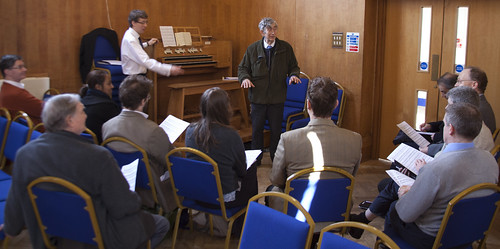 |
| At last's year's course, Colin Mawby discussing organ accompanyment. |
Gregorian Chant Network Chant Training Weekend:
An intensive chant course running alongside the Catherine's Trust Family Retreat (led this year by Fr Serafino Lanzetta). Singers will be prepared to participate in the liturgies of the Retreat, including Mass Ordinaries and Propers, Chants for Benediction and the Office, as well as discussing chant interpretation and history. All liturgies are according to the usus antiquior (the Traditional Mass). With two chant tutors, the group can be split for some purposes into more and less experienced, so everyone can get the most out of it.
Large discounts available for groups coming from choirs and scholas affiliated to the Gregorian Chant Network.
Support the work of the LMS by becoming an 'Anniversary Supporter'.
Opus Anglicanum: a belated review
 The exhibition Opus Anglicanum in the Victoria and Albert Museum in London is about to close: it does so on 5th. Right now the exhibition webpage is still up so you can see a few things about it. We went to see it before Christmas, and I thought I'd put up some random observations.
The exhibition Opus Anglicanum in the Victoria and Albert Museum in London is about to close: it does so on 5th. Right now the exhibition webpage is still up so you can see a few things about it. We went to see it before Christmas, and I thought I'd put up some random observations.
 The exhibition shows off the work of Medieval English needlecraft, which was famous in its own day. This is embroidery used on a lavish scale, not simply to decorate an orphery but to cover entire chasubles, the vast copes they used in that period, and all sorts of other things. It is a tradition dating back to before the Norman Conquest: the Bayeaux Tapestry was made by English needleworkers. However, most of the surviving examples, in this exhibition, are from the 14-16th centuries. English work was so prized that these pieces made good diplomatic gifts, which is the reason that several of the things in the exhibition have survived, in cathedrals in continental Europe. Liturgical vestments covered in pictures of virgin martyrs could have a short life-expectancy in Protestant England.
The exhibition shows off the work of Medieval English needlecraft, which was famous in its own day. This is embroidery used on a lavish scale, not simply to decorate an orphery but to cover entire chasubles, the vast copes they used in that period, and all sorts of other things. It is a tradition dating back to before the Norman Conquest: the Bayeaux Tapestry was made by English needleworkers. However, most of the surviving examples, in this exhibition, are from the 14-16th centuries. English work was so prized that these pieces made good diplomatic gifts, which is the reason that several of the things in the exhibition have survived, in cathedrals in continental Europe. Liturgical vestments covered in pictures of virgin martyrs could have a short life-expectancy in Protestant England.
Something which did survive in England was a truly wonderful coffin-cover made for, and still owned by, the The Worshipful Company of Fishmongers, complete with mermaids. The survival of these curious medieval institutions, and their innate conservatism, is one of the fun things about England.
The practice of English embroidery was saved from extinction by (what became) the Royal College of Needlework, founded in 1872: we owe the Victorians a lot. What they do, the kind of stuff you see above all on state occasions and in well-resourced Anglican cathedrals, is a direct descendant of this medieval work. What is interesting, however, is that the medieval artists used a very limited number of techniques. The great majority of the embroidery is one kind of stitch, called 'split stitch'. Another type, 'tent stitch', was used for heraldic embroidery, which was less fine and designed for hard use; it makes sense to create blocks of colour.
 This split-stitch embroidery is very similar to modern 'silk shading', which you'll see today, for example, for faces on vestments; but the thread used was far coarser. The result is a wooly, rather than a silky, effect, which would I suppose have been more hard-wearing and also much faster to execute. Like silk shading, it can shade seemlessly from one colour into another, with texture being created by the direction of the stitches. So the cheeks of a female saint, for example would shade into a deeper pink in the middle, with the impression of roundness being given by a pattern of stitches in concentric circles.
This split-stitch embroidery is very similar to modern 'silk shading', which you'll see today, for example, for faces on vestments; but the thread used was far coarser. The result is a wooly, rather than a silky, effect, which would I suppose have been more hard-wearing and also much faster to execute. Like silk shading, it can shade seemlessly from one colour into another, with texture being created by the direction of the stitches. So the cheeks of a female saint, for example would shade into a deeper pink in the middle, with the impression of roundness being given by a pattern of stitches in concentric circles.
The skill of the artisans must have been immense, and the value of their work enormous. To have a cope covered with more than a dozen saints and associated symbols and decoration can't have been any cheaper than covering it in semi-precious stones, and it was valued accordingly. Indeed, among the sumptory laws of the period, intended to restrain extravagance, embroidery on clothing was restricted to people of a certain income and social standing.
 I noted some time ago on this blog something else about this exhibition which is interesting. Before it opened The Guardian carried a story about it, noting
I noted some time ago on this blog something else about this exhibition which is interesting. Before it opened The Guardian carried a story about it, noting
'for the first time in decades, the museum has dared to use Latin in an exhibition title.'
It explained:
“We were a bit worried that people would find the title baffling,” said co-curator and textile expert Clare Browne. “Older people thought that younger people would find it off-putting – but in fact younger people thought it was mysterious and exciting.”
Support the work of the LMS by becoming an 'Anniversary Supporter'.
Mass in Milton Manor Sat 11th Feb
Support the work of the LMS by becoming an 'Anniversary Supporter'.
What, then, should we do? Part 3: what it means for you.
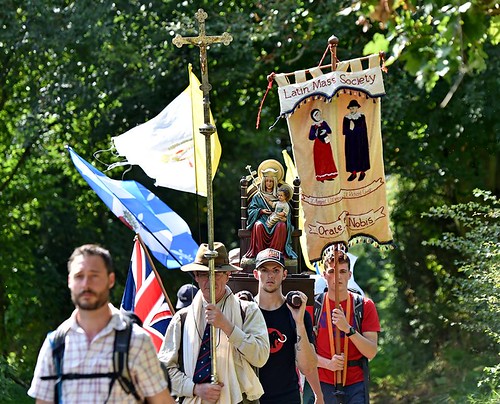 |
| Latin Mass Society Waling Pilgrimage to Walsingham. |
In the last two posts I have given a number of reasons why the defence of the Faith and those upholding it will best be done through the movement for the restoration of the Traditional Mass. This post is about what that means in practice for you, dear reader.
4. The movement’s historical experience has effectively innoculated it against Papolatry.
Support the work of the LMS by becoming an 'Anniversary Supporter'.
What, then, should we do? Part 2: why the Traditional Mass
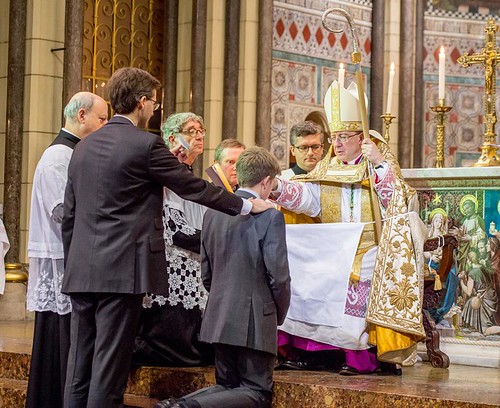 |
| A young man being made a soldier of Christ, at the Traditional Confirmation ceremony organised by the Latin Mass Society in London. |
The first post in this series is here.
The Church is enriched by all sorts of organisations and movements, many of them doing good work. I have just argued that in response to the current crisis Catholics of good will should rally to the banner of the Traditional Mass, and the movement which supports it. Why? What is wrong with all the other organisations and movements in the Church, and indeed one’s own geographical parish?
Support the work of the LMS by becoming an 'Anniversary Supporter'.
What, then, should we do? Part 1: what is required.
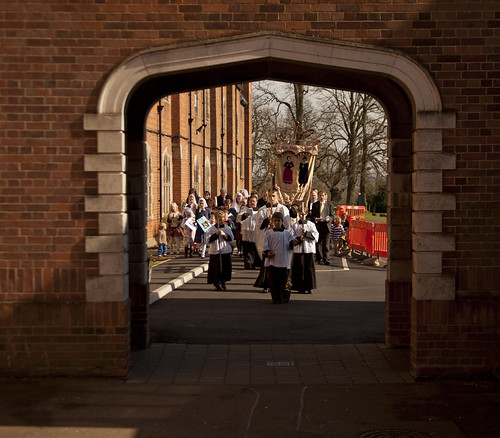 |
| They are coming... A procession at the St Catherine's Trust Family Retreat. |
People keep asking this question; it is a fair question, and I want to try my hand at answering it. This is the first of a series of three posts on the subject.
The question refers to the current crisis in the Church. This may dissipate tomorrow by some intervention of Providence, but we must be prepared for the crisis to develop further according to its own logic. On this logic, we can expect priests and laity to come under increasing pressure to deny and to act contrary to the immemorial and irreformable teaching of the Church, the explicit teaching of Christ in the Gospels and of St Paul in the Epistles, about divorce and the sacraments.
To clarify what may seem puzzling, a mass movement to preserve orthodoxy cannot simply promote orthodoxy. Such a purpose would be too thin to bind it together. It would work for an elite group whose members can maintain personal relationships with each other. It would work for a formal organisation, which tied people together with a stable leadership, membership fees, newsletters, and regular events. It won't work for a movement which is diffuse, i.e. not centralised, and has a mass, not elite, membership. In a very vague sense there is already a 'movement to preserve orthodoxy' in the Church, but it is not remotely dense enough to provide systematic support for priests and laity who need it, and is riven with disagreement about what orthodoxy entails. What is needed for this particular job is a movement based around something which gives the notion of orthodoxy some more definite content, and at the same time gives its members something distinctive (distinctive from the heterodox, that is), in common. Something which can act as the movement's banner, or uniform.



